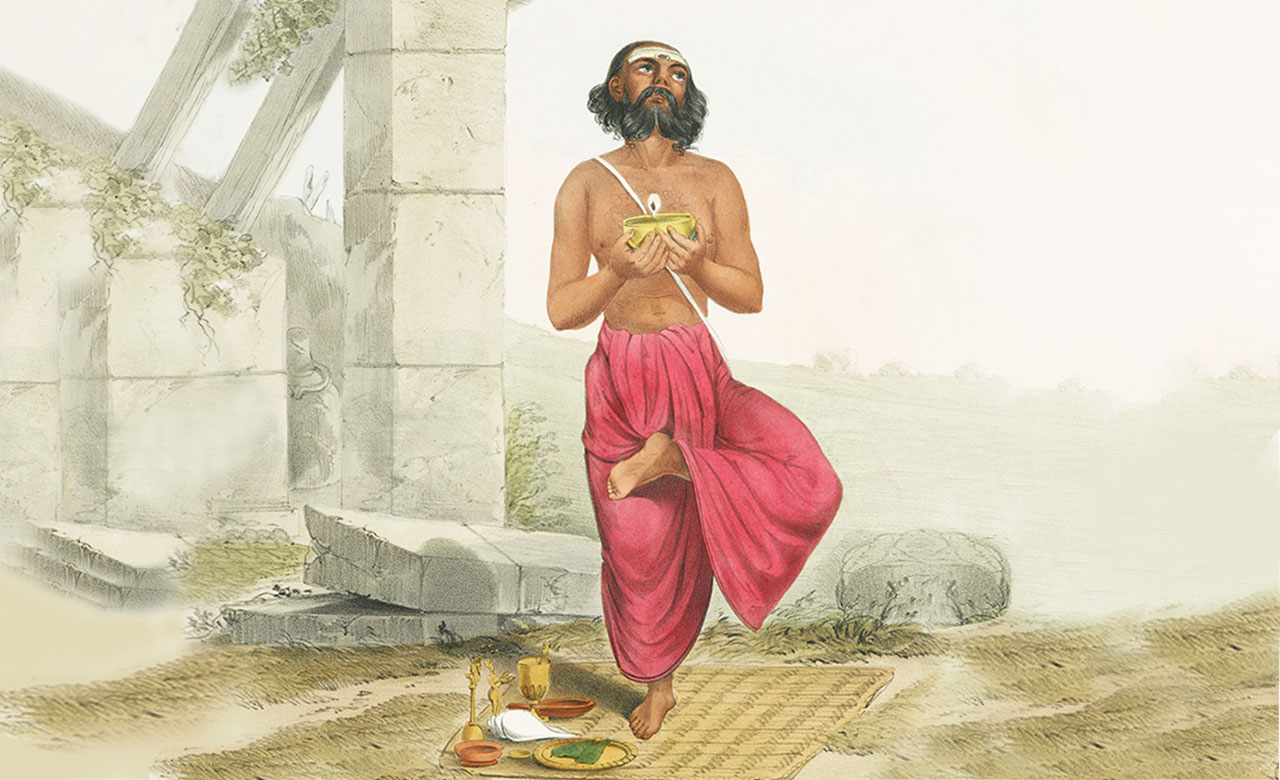
Informative
Manaspuja (The Worship in the Mind)
During medieval times, a king was ruling the state of Tamilnadu. He built a gigantic and lavish Shiva temple, sparing no expense. While he was meditating, he invited Lord Shiva to the temple. To his surprise, the Lord replied, saying he won’t be coming there tomorrow, as He has to visit another temple – more lavish, more grandeur than this, which was being constructed in a nearby village. Lord even told the king, who was building the temple.
The king was surprised to know that someone was building a more beautiful temple in the nearby village without his knowledge. He was more surprised when he found out that the person who is constructing a temple is a penniless fellow and does not even have enough money to build a hut for himself. When the king enquired about the location of the temple – the poor fellow replied, “O dear King, it’s in my heart.” That’s the real power of Manaspuja.
Manas means Mental, and Puja means worship. In Hinduism, traditionally, a puja comprises 16 Upacharas or offerings, including meditation, water, bath, clothes, flowers, lamp, food, etc. But instead of using the physical objects, Manaspuja involves offering all these to your Ishtadev in mind.
Why Manaspuja?
It is hard to find a time to perform actual worship or visit the temple in our busy schedule. Unlike the good old days, mental peace is difficult to get in this turbid and depraved atmosphere. In such conditions, Manaspuja is the best way to reach the holy feet of the Almighty.
In the ancient Vedic texts, it’s considered the best kind of worship among all, as it involves utilizing what is essentially your ego as all these items for prayer, let it go. In physical Puja, your mind may drift away, but in Manaspuja, you are continuously connected with the divine, combining all of your senses, willpower, Karma, and emotions concentrated. Swamiji says, that “Once the form of Ishtadev is established in the Sadhak’s heart, this bond to the heart will remain, and will continuously enlive the devotion .”
Manaspuja Procedure
The individual having a thirst for self-knowledge and unconditional love for the divine have many ways to reach towards liberation through knowledge (Gyaan Yoga), the path of action (Karma Yoga), or via the path of loving devotion (Bhakti Yoga). The practice, which needs absolute mental participation, is, in fact, one of the most remarkable aspects of Bhakti Yoga, where all you need is your mind and heart, and rest of the ritual materials, can be gathered in our mind.
Preparation:
One should be having a night of adequate sleep, not less, and not more.
One should avoid spicy and oily food, and the food portion should be just enough to nourish the body.
One should only speak when necessary, and one should avoid backbiting in any form.
Superior control over the mind, untouched by the doubts, negativity, and distractions.
The best time for Manaspuja is at Brahma Muhurta, approximately between 4:30 to 5:30 AM, which is considered the best time for meditation.
-One must take a bath and wear cotton clothes and sit down in a crossed leg position, keeping the eyes closed while concentrating on breathing, visualizing the following procedure in his mind.
Procedure:
-Awahana: With the chanting of Gurumantra in mind, or the specific Mantra for their Ishtadev, welcome the Ishtadev in your heart.
-Paadyam: As you imagine your Ishtadev coming near you, imagine washing their holy feet with water.
-Arghyam: Along with the holy feet of the divine, wash the blessed hands of your Ishtadev with water, mixed with feelings and emotions.
-Achamanam: Offer water to your Ishtadev with utmost respect and love.
-Maarjanam: You can bathe the idol of the divine with water, Panchamrit, and again, with holy water, from the utensils made up of gold, and several diamonds decorating it.
-Vastram: Each deity has a specific color. For example, for the Divine Mother Durga, it’s a red color, for Lord Vishnu, it’s Saffron and white for Divine Mother Saraswati. Offer the specific colored handsome clothes to the Ishadev, along with charming jewelry.
-Yajnopaveetam: Sacred thread, or its also called Janeu, should be offered to the Ishtadev as a sign of purity of thoughts, words, and deeds of the wearer.
-Gandham – Apply a sandalwood paste to activate the Sun Channel of the Ishtadev, enhancing the divine consciousness of the idol.
-Pushpam: Offer flowers, and garlands, made with the favorite flowers of your Ishtadev.
-Dhoopam: Offer an incense stick emitting a fragrance, which creates a soothing, pious, and pleasant environment. Provide your breath (Prana) as incense to the divine.
-Deepam: Lighting an oil lamp repels negativity, and with a Ghee (clarified butter) lamp, one attracts positivity in his surroundings. Visualize igniting a light in front and surrounding your beloved Ishtadev.
-Naivedyam: Present your Almighty with delicious cuisine. Tasty yet simple food, prepared with utmost love and devotion.
-Tamboolam: Offer Tamboolam or betel leaf to your Ishtadev after they have consumed the offerings. Betel leaf is a symbol denoting freshness, prosperity, along with auspicious celebrations.
-Neerajanam: Visualize igniting camphor in front of Ishtadev. It symbolizes union with the divine. Just as the camphor burns itself out without leaving any residue, so does burning one’s ego in the fire of true knowledge leads to union with God.
-Mantra Pushpam: Thank your Ishtadev for accepting your offerings. In the form of the Mantras, praise the divine, observing how gorgeous your almighty is looking, how pleased the divine is, and how charming their smile is. With an open heart, share your sorrows, difficulties, stories, about yourself, and whatever is in your mind with your Ishtadev.
Before exchanging farewells, remember to express your appreciation towards Ishtadev for a visit and seek forgiveness for the mistakes or lapses you must have committed during the worship.
When performed with love and devotion for God, combined with mental purity, Manaspuja gives terrific results. Ancient texts like Vedas and Upanishads describe Manaspuja as the highest form of Puja and can be done sitting at home without involving costs or bothering anyone. Not only it calms the mind, but at the same time, it engages the mind directly in the process of worship, creating a more profound and more powerful spiritual experience.
Remember, you are the Lord of your inner universe. Just like Lord Brahma, you can also create anything with your limitless imagination. If you set your mind to it, you can easily manifest and invite your Ishtadev in your subconscious and awaken the divine within you.
Swamiji always advises holding your Sankalp in the present. As you keep on practicing the Manaspuja, remember that your mind, your Chakras, your Kundalini combined with celestial powers of the world, will manifest the same reality in the external world as well. And hence, Manaspuja is considered a very effective method of internal worship.
Especially during these pandemic times, when we are stranded at homes, avoiding crowded places, Manaspuja could be the better alternative to visiting your regular site of worship.
Manaspuja is the enriched form of meditation and mindfulness combined with ritual practices, performed with concentration and devotion. You have performed rituals. You have practiced meditation. Are you ready to combine all of these in one? Welcome to your inner universe.
We request you to give it a try to Manaspuja. Share your experience with us. If you have any questions regarding the objective, process, or any other aspect of Manaspuja, do not hesitate to write to us at info@ChamundaSwamiJi.com. We would love to hear from you.
Post a Comment
-
Subscribe to Our Blog
-
Categories
-
Popular Articles
- Dead moth in the house. What universe is trying to tell you?
- Spiritual Meaning of Moth
- Vivah Bandhan Curse – What Is It and How to Spiritually Heal It.
- The Dasa Mahavidyas
- What are Beej Mantras?
- Tripura Sundari | The Dasa Mahavidya
- Maa Bhuvaneshwari | The Dasa Mahavidyas
- The Five Shades of Tantra
- Ramakrishna Paramhansa – The Man who almost became a Woman
- Maa Chinnamasta | The Dasa Mahavidyas



